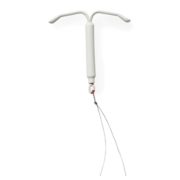For less than 1 in 1,000 people having an IUD placed, the IUD can get stuck in or
puncture the uterus—also known as perforation. Perforation only happens when the IUD is being put in. Highly skilled providers who have inserted many IUDs are less likely to cause perforations. If you have given birth recently you are more likely to experience perforations because the muscle of the uterus is softer then.
What does it mean if there is a perforation? If it’s recognized immediately, the health care provider will stop the insertion. It takes about a week for the uterus to heal, and then you can have another IUD inserted if you want. However, more than half of perforations may go unrecognized at the time of insertion. Because the IUD has to be correctly placed to work as birth control, that may mean that you don’t have birth control when you think you do. While it’s not required, you can have a follow up visit with a provider to check the IUD 4 to 6 weeks after it’s placed or check the IUD strings in the vagina yourself. If you can feel the strings with your fingers, everything’s probably okay.
If undiagnosed for months, a perforation can make removing the IUD difficult and can sometimes require surgery to remove it. Even in the worst-case scenario of an undiagnosed perforation that requires surgery, it shouldn’t have an impact on your chances of getting pregnant in the future.
For less than 1 in 1,000 people having an IUD placed, the IUD can get stuck in or puncture the uterus—also known as perforation. Perforation only happens when the IUD is being put in. Highly skilled providers who have inserted many IUDs are less likely to cause perforations. If you have given birth recently you are more likely to experience perforations because the muscle of the uterus is softer then.
What does it mean if there is a perforation? If it’s recognized immediately, the health care provider will stop the insertion. It takes about a week for the uterus to heal, and then you can have another IUD inserted if you want. However, more than half of perforations may go unrecognized at the time of insertion. Because the IUD has to be correctly placed to work as birth control, that may mean that you don’t have birth control when you think you do. While it’s not required, you can have a follow up visit with a provider to check the IUD 4 to 6 weeks after it’s placed or check the IUD strings in the vagina yourself. If you can feel the strings with your fingers, everything’s probably okay.
If undiagnosed for months, a perforation can make removing the IUD difficult and can sometimes require surgery to remove it. Even in the worst-case scenario of an undiagnosed perforation that requires surgery, it shouldn’t have an impact on your chances of getting pregnant in the future.

